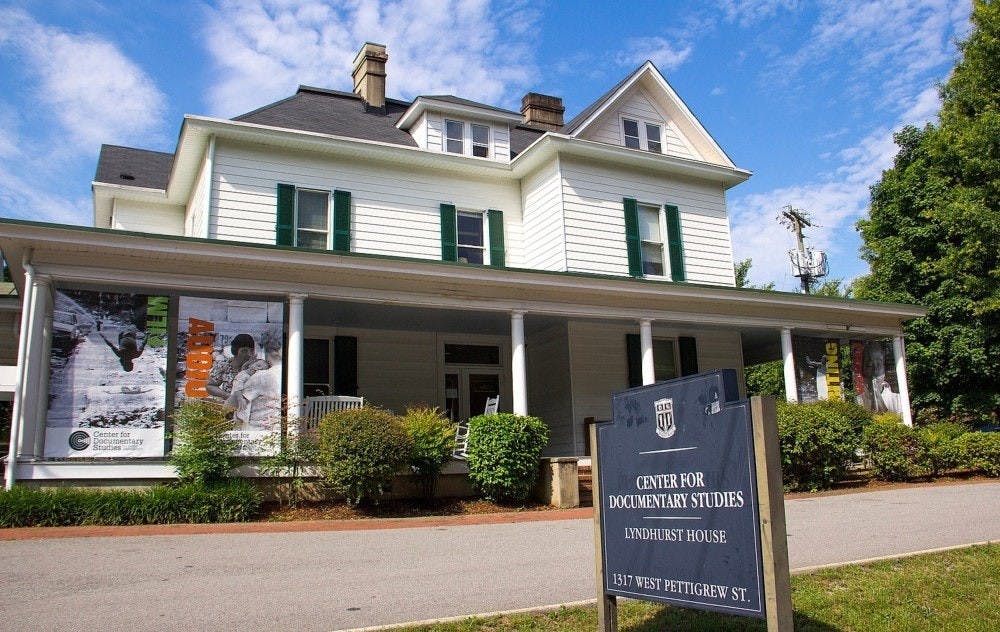Climate change is a topic that is at once impersonal and urgent. Although nearly every successive climate change report seems to pull the due date of impending calamity ever closer to the present, climate change coverage has refrained from politicizing the issue, often turning a lens to a small handful of the big players, like national governments.
In “One Hurricane Season,” a Center for Documentary studies exhibition on display until Feb. 17, MFA/EDA alumna and native Bahamian Tamika Galanis aims to enrich and individualize the conversation on climate change by threading it through a summer spent with her grandmother in the Bahamas at the height of hurricane season.
In an essay for “Oxford American,” Galanis contextualizes her exhibition by synthesizing the sudden and large-scale destruction experienced in the wakes of Hurricanes Irma and Maria with the rapid progression of dementia that afflicted her grandmother. As Atlantic “Small Island Developing States” (SIDS), including the Bahamas, look to the future, they see a fate of disappearance already experienced by their counterparts in the Pacific.
The preservation of Bahamian livelihood, humanity and culture shoulders an urgency that parallels Galanis’ sudden commitment to collect and retain the pieces of family history left behind by her grandmother. The future threat of dissolution faced by Bahamian people and culture is further overcast by the touristic presentation of the Bahamas as an island paradise, devoid of human contact. It is in the shadow of these dual threats that Galanis does her work, placing a multifaceted lens wholly on a people and culture that have never received one from the ubiquitous ad agencies and who merit such a lens sooner rather than later.
“This show — and the objective of my practice — is to document as much of the Bahamian experience as I can in a place that is in grave danger of disappearance,” Galanis said. “The people and the landscape are equally important: Bahamian vernacular is inclusive of language, culture, aesthetics, flora, fauna, etc. Every detail is important.”
“One Hurricane Season” is a change of pace from traditional photography, incorporating a range of multimedia aspects, including video, sound, photography and collage, into four separate installations that fit together in theme and artistic intent. The installations engage multiple senses — sight, sound and texture, along with movement — to create an experience that is at once immersive and intimate for the viewer, yet distinctly rooted in Galanis’ experiences as a native Bahamian. Galanis has a somewhat documentarian family history: Her grandfather was an avid photographer, as was her father, and they both diligently worked to document the day-to-day life of their families with a care and fondness that is evident in Galanis’ own work.
Installations like “Into the Ether,” in which Galanis incorporates bits of Bahamian ecology like conch shells, mango leaves and poinciana bark with monoprints of her family, demonstrate the embeddedness of her own Bahamian family history in the country’s ecology.
“A Thousand Points of Light” is a family video installation overlaid with a recording of Dominica prime minister Roosevelt Skerrit’s address to the U.N. General, in which he entreats the assembly for action against climate change. It shines a light on the environmental justice aspect of climate change by implying that it not only threatens the ecology of a place, but also the livelihood of the people incorporated into that very ecology.
“Although the people in [“A Thousand Points of Light”] are my family, they represent the people of the region as a whole,” Galanis said. “They remind us of what's in danger of disappearance without climate intervention — the historical narrative as it pertains to Black bodies in the Caribbean — is one of erasure. Everyday occurrences are eclipsed by the paradise narrative — these films are a reminder that we are real people living full lives and the stakes are high.”
Other installations, including a compilation of Bahamian visio-auditory clips in which the camera is depersonalized and omniscient, and a collection of photographs of lived-in or worn homes, pathways and garden gates, work together to present a viewpoint of the Bahamas that reaches far beyond its famed white, sandy beaches. By neatly placing the viewer within the experience of a native Bahamian, and by allowing one to vicariously view the quotidian landscape of a Bahamian, Galanis manages to compose an exhibit that is as intimate for its audience as it is for her.
“When I make work, I'm always striving to understand something a bit more — I'm an observer,” Galanis stated. “I venture to make images that mirror my experiences, just as I think or want others to experience them — as isolated slices of a whole: everyday occurrences that are often overlooked.”
Such a personal rendering of climate change is much needed break from typical media coverage of the topic. It even differs from narratives of environmental justice, which, as a component of social justice, must often focus on marginalized peoples as groups. It serves to contextualize a discussion that is frequently abstracted and depersonalized, perhaps highlighting the potential of artists in a realm rarely attributed to them: science and public policy. When artists like Galanis bring to light the emotional impact of climate change and thereby implicate its urgency, their work is rendered in a new, and valuable, light.
Get The Chronicle straight to your inbox
Signup for our weekly newsletter. Cancel at any time.

